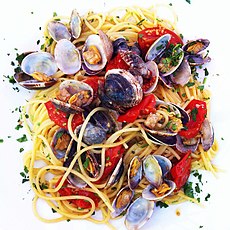Rosetta (bread)
Rosetta (bread)
The Rosetta is a type of bread that originated in Italy. It is also known as Michetta in some regions of Italy. The bread is notable for its distinctive shape, which resembles a rose or a star, and its soft, airy interior.
History[edit | edit source]
The Rosetta bread was first created in the early 19th century in Lombardy, a region in Northern Italy. The bread was initially made as a cheaper alternative to the more expensive French bread, and quickly gained popularity due to its unique shape and texture.
Characteristics[edit | edit source]
The Rosetta is a small, round bread that is hollow on the inside. The bread is made by making a round dough, which is then cut into a star or rose shape before being baked. This gives the bread its distinctive shape, which is said to resemble a rose or a star. The bread is typically soft and airy on the inside, with a slightly crunchy crust.
Preparation[edit | edit source]
The preparation of Rosetta bread involves several steps. The dough is made from wheat flour, water, yeast, and salt. The dough is then allowed to rise for several hours before being shaped and baked. The baking process involves high heat, which causes the dough to puff up and create the bread's characteristic hollow interior.
Uses[edit | edit source]
Rosetta bread is often used in Italian cuisine as a sandwich bread. It is commonly filled with various types of cheeses, cold cuts, and vegetables. The bread's hollow interior makes it ideal for holding fillings.
Variations[edit | edit source]
There are several variations of Rosetta bread, including the Michetta, which is similar in shape but slightly larger and has a more pronounced crust. Other variations include the Rosetta di Rimini, which is made with olive oil and has a softer texture.
See also[edit | edit source]
 |
| Italian cuisine |
|---|
| |
Search WikiMD
Ad.Tired of being Overweight? Try W8MD's physician weight loss program.
Semaglutide (Ozempic / Wegovy and Tirzepatide (Mounjaro / Zepbound) available.
Advertise on WikiMD
|
WikiMD's Wellness Encyclopedia |
| Let Food Be Thy Medicine Medicine Thy Food - Hippocrates |
Translate this page: - East Asian
中文,
日本,
한국어,
South Asian
हिन्दी,
தமிழ்,
తెలుగు,
Urdu,
ಕನ್ನಡ,
Southeast Asian
Indonesian,
Vietnamese,
Thai,
မြန်မာဘာသာ,
বাংলা
European
español,
Deutsch,
français,
Greek,
português do Brasil,
polski,
română,
русский,
Nederlands,
norsk,
svenska,
suomi,
Italian
Middle Eastern & African
عربى,
Turkish,
Persian,
Hebrew,
Afrikaans,
isiZulu,
Kiswahili,
Other
Bulgarian,
Hungarian,
Czech,
Swedish,
മലയാളം,
मराठी,
ਪੰਜਾਬੀ,
ગુજરાતી,
Portuguese,
Ukrainian
Medical Disclaimer: WikiMD is not a substitute for professional medical advice. The information on WikiMD is provided as an information resource only, may be incorrect, outdated or misleading, and is not to be used or relied on for any diagnostic or treatment purposes. Please consult your health care provider before making any healthcare decisions or for guidance about a specific medical condition. WikiMD expressly disclaims responsibility, and shall have no liability, for any damages, loss, injury, or liability whatsoever suffered as a result of your reliance on the information contained in this site. By visiting this site you agree to the foregoing terms and conditions, which may from time to time be changed or supplemented by WikiMD. If you do not agree to the foregoing terms and conditions, you should not enter or use this site. See full disclaimer.
Credits:Most images are courtesy of Wikimedia commons, and templates Wikipedia, licensed under CC BY SA or similar.
Contributors: Prab R. Tumpati, MD
